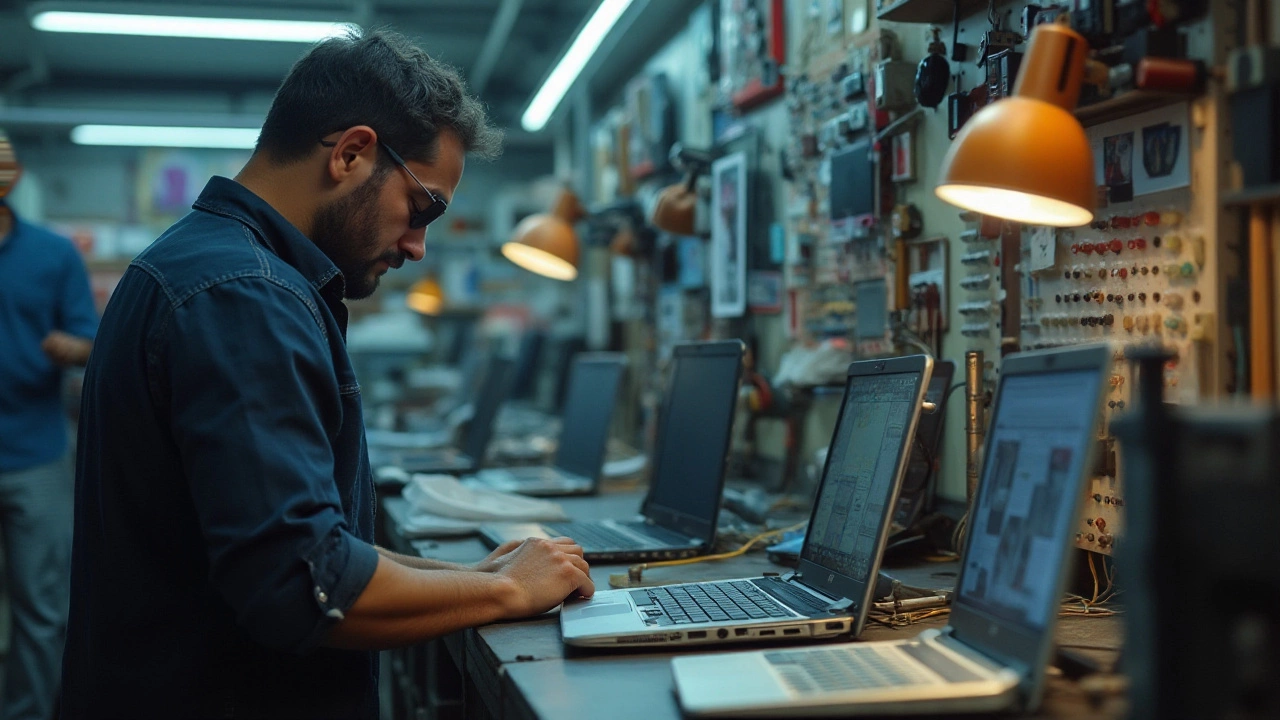Laptops are an essential part of our daily lives, but like any piece of technology, they are not immune to malfunction or damage. Amongst the various repairs these devices may need, some parts are particularly costly to fix. The heart of this article is to uncover which component of a laptop packs the heftiest repair price tag.
One might immediately think of the motherboard or other internal components, but surprisingly, screens often win this title for several reasons. Not only are the screens complex and delicate, but their repair can also be labor-intensive. This complexity contributes to the high cost, both in parts and labor.
We will guide you through the reasons why screen repairs can be so expensive, offer practical maintenance tips to help you avoid such issues, and suggest alternatives that might save you a pretty penny in the long run. By the end of this read, you'll be equipped with knowledge that'll keep your laptop, and your wallet, in better shape.
- The Priciest Component: Laptop Screen
- Why Screens Top the Repair Costs
- Maintenance Tips to Avoid Expensive Repairs
- Alternatives and Solutions for Costly Damages
The Priciest Component: Laptop Screen
When it comes to laptop repair cost, the screen often emerges as the most expensive component. These displays are a marvel of engineering, combining lightness, clarity, and vibrant color presentation. Yet, this sophistication doesn't come cheap, especially when damage occurs. Touchscreens, in particular, involve complex technologies like capacitive touch sensors that add an extra layer of cost and intricacy. A damaged screen can range from cracked glass to issues with the LED or OLED panels beneath—each with varying degrees of difficulty and cost to repair.
Consider the process of replacing a laptop screen. It requires careful dismantling of the laptop, which is an art in itself. The fragility of screen components means that technicians must handle them with the utmost precision. With many laptops trending towards thinner bezels and lighter bodies, the screens have evolved to be slimmer and more integrated into the device structure. This evolution has reduced repair accessibility, pushing up labor time and expenses. In fact, it's common knowledge that replacing a MacBook Pro's Retina display can cost anywhere from $250 to $700, depending on the model.
Another factor driving up the expense is the diversity of screens. Unlike in the past where uniformity was more common, screens today vary vastly in size, resolution, and technology, from Full HD to Retina and 4K LED screens. Consequently, sourcing the correct replacement part can be both challenging and costly. As technical specifications multiply, so does the retail price of these components. The rarity of components for niche models, or those from boutique tech producers, often leads to scarcity-induced price hikes.
Interestingly, an often-quoted article from Laptop Magazine highlights the concern sharing,
"Screen repairs remain consistently high. As consumer preferences shift towards better display quality and features, repair costs reflect this advancement."This quote captures the duality of technology's advancement—bringing both enjoyment and care requirements.
There's also the question of whether to repair or completely replace the laptop when the screen is damaged, mainly if the model is several years old. It poses an economic consideration: at what point is fixing an old screen less practical than investing in a new device? Such considerations are increasingly essential as technology progresses rapidly. Moreover, for those keen on maintaining their devices, protective measures like screen protectors and timely maintenance can prevent untimely and costly repairs.
To allow readers a better grasp on different screen costs, take a look at the example table of replacement prices below, which highlights the price disparities among popular devices:
| Device | Approximate Screen Replacement Cost |
|---|---|
| MacBook Pro 13" (2020) | $400-$750 |
| Dell XPS 13 (2021) | $350-$650 |
| Lenovo ThinkPad X1 Carbon (2022) | $300-$550 |
Understanding why the screen is the priciest laptop component to repair sheds light on the broader context of laptop economics. This knowledge not only empowers you to make informed decisions regarding your own devices but also prompts manufacturers to continue improving both the durability and affordability of these indispensable technologies. For any laptop owner, recognizing and preparing for potential repair costs is a step towards becoming a more savvy and resourceful tech user.

Why Screens Top the Repair Costs
When we dive into the realm of laptop repairs, screens undeniably emerge as one of the most costly components. But why is that the case? Let's unfold the layers of complexity that contribute to such elevated repair costs. First and foremost, the laptop display is not just a piece of glass. It consists of multiple layers, including the front panel and the delicate digitizer, which all work together to provide a responsive and vibrant viewing experience. The repair of such layers demands precise care, and any missteps can easily lead to more damage rather than mending. That intricacy in the assembly contributes significantly to the labor costs involved in repairs. In other words, it's not just about replacing the visible surface but tackling an in-depth rebuild of the screen.
Moreover, a variety of display types like Retina, 4K, and touchscreens, to name a few, have different requirements. A Retina display from Apple, for example, can have a hefty price tag just for the part alone. Comparatively, upgrading from a standard screen to a higher-resolution or touch-enabled one entails more demands on the hardware and boosted manufacturing precision, resulting in substantial costs. Laptop screen replacement thus attracts steep fees, especially when you factor in proprietary technologies and brand-specific components. This makes their repair more expensive due to the lack of standardized parts across different brands and models.
Another layer to this cost structure is the brand-specific aspect. Laptop manufacturers often design models uniquely, requiring specific screens for each. The customization results in less availability of universal parts, thereby limiting the options for low-cost replacements. In some cases, the screen components, which include the bezel, digitizer, and display itself, might need to be replaced as a single unit, leading to an increase in costs. According to John Turner, a seasoned tech analyst,
"The proprietary nature of display panels is like the fingerprint of a device; no single solution fits all, which adds to the mystique and the price tag."
Let's not forget the transport and handling risks involved in screen replacements. During the journey from the manufacturer, packaging, installation, and testing, there's always the looming possibility of damage due to the fragile nature of these components. Damaged screens account for a notable proportion of laptop repairs, and thus, maintaining a high quality of service necessitates cautious handling, further straining budgets due to potential warranty replacements. To round out this picture, the fluctuating market prices for component parts also impact repair expenses. Commodity prices, supply chain disruptions, and the emergence of novel screen technologies can drive prices up. This dynamic market landscape keeps laptop screen repair expenses high and unpredictable, emphasizing the necessity of understanding these factors for consumers who wish to make informed decisions.

Maintenance Tips to Avoid Expensive Repairs
When it comes to your precious laptop, savvy maintenance is the secret to avoiding those dreaded and costly repair bills, especially for components like the laptop screen. The good news is, there are several simple actions you can take to bolster your device against the typical wear and tear. To kick things off, ensure you handle your laptop with care. It sounds basic, but accidents frequently occur due to seemingly harmless habits. For instance, picking up your laptop by the screen rather than the base can lead to stress on the hinges, which in turn may crack or damage the display.
Another vital aspect is keeping your laptop clean, both outside and in. Dust and debris can sneak into the crevices around your screen and keyboard, eventually damaging internal components. Invest in a good microfiber cloth and give your screen and exterior a gentle wipe every few days. When it comes to internal cleanliness, consider a canned air duster to clean out the ports and other openings. This small effort can prevent costly laptop repair costs in the future. You'll be amazed at how a simple cleaning schedule can protect your device from overheating due to dust blockers.
Now, let’s talk about protection – a sturdy laptop bag or case is a must-have. Dropping a laptop, even from a small height, can result in significant damage to the screen and other components. Choose a case with adequate padding to absorb shocks, and never stuff multiple laptops into a single bag to prevent undue pressure. A well-chosen bag safeguards your device beyond just the laptop screen replacement; it protects the keyboard, body, and internal organs of the device too.
On a more technical note, regularly updating your software is crucial. Software glitches can often mimic hardware issues and can even lead to unnecessary stress on hardware components. Always ensure your operating system and drivers are up-to-date. This might prevent performance issues that could eventually cause breakdowns requiring expensive repair tips. Besides, an updated system often provides better security against potential threats and malware that could compromise your laptop.
"An ounce of prevention is worth a pound of cure," goes the old adage, pointing to the wisdom that safeguarding your technology today will save you from regretting bills tomorrow.
Additionally, use a surge protector if you're in an area susceptible to voltage spikes. Fluctuations in power can wreak havoc on your laptop's components, leading to detrimental damage that calls for significant repair work. Such protectors are inexpensive compared to the costs of component replacements and shield your computer from unseen yet powerful threats. Last but not least, remember to back up your data regularly. While this doesn’t prevent hardware damage, it ensures your valuable files are safe should worst come to worst. In the realm of laptops, being prepared means fewer panics over what could go wrong.

Alternatives and Solutions for Costly Damages
When faced with the potentially steep laptop repair cost, exploring alternatives and solutions can be a game-changer. If your laptop screen is cracked or exhibiting display issues, it's important to weigh your options before rushing to the repair shop. One attractive solution is considering DIY repair kits available online. These kits come equipped with the necessary tools and instructions, making it feasible for tech-savvy individuals to replace a damaged screen themselves. However, this approach demands a level of confidence and knowledge about the internal workings of laptops.
Alternatively, seeking out local repair shops as opposed to brand-specific service centers might reduce the repair cost. Local technicians often charge less for labor compared to big-chain service centers, and they might be more flexible with negotiation on costs. Keep in mind, though, the quality and warranty of the parts used might vary, which is critical when deciding where to go for repairs. It's also worth checking if your laptop is still under warranty. This can save you from out-of-pocket expenses, as manufacturers often cover the costs for certain types of damages.
Refurbished and second-hand parts are another cost-effective option. These components can often be sourced online at a fraction of the cost of new parts. Yet, there is a trade-off between cost and longevity, as these parts might not last as long as brand-new ones. Checking customer reviews and ratings can guide you towards reputable sellers. If the issue is beyond repair or the cost doesn't justify it, consider investing in a second-hand or refurbished laptop. This not only addresses immediate needs but can be an environmentally friendly option.
"Sometimes, buying a well-functioning second-hand laptop might be more sensible than pouring money into repairs," advises tech expert David Anders from TechRadar.
If these damages occur frequently and disrupt productivity, comprehensive damage insurance might be worth considering. Though it's an additional expense, it provides peace of mind, covering repair or replacement costs in various scenarios. It's crucial to compare different insurance policies, as coverage and premiums differ significantly.
Moreover, addressing the root causes of these laptop issues can save you both time and money in the long run. Implementing protective measures like screen protectors and sturdy cases can significantly diminish the risk of screen damages. Additionally, regular maintenance, such as cleaning dust from vents and ensuring proper ventilation, helps prevent overheating—a common cause of internal failure.
The advancement in cloud computing and storage solutions provides another avenue to explore. With most work and personal data stored in the cloud, even if your laptop becomes unusable, your data remains safe and accessible from other devices. Cloud services have made it possible to continue work on different platforms without much hassle. In the context of high repair costs, considering such alternatives not only helps financially but also opens up new ways of managing and protecting your tech investments efficiently.

I am an expert in the services industry with a focus on appliance repair. My passion lies in understanding how things work and educating others in simple, engaging ways. This enthusiasm fuels my writing, where I delve into topics around appliance maintenance and troubleshooting. I aim to make these subjects clear and accessible to all readers.